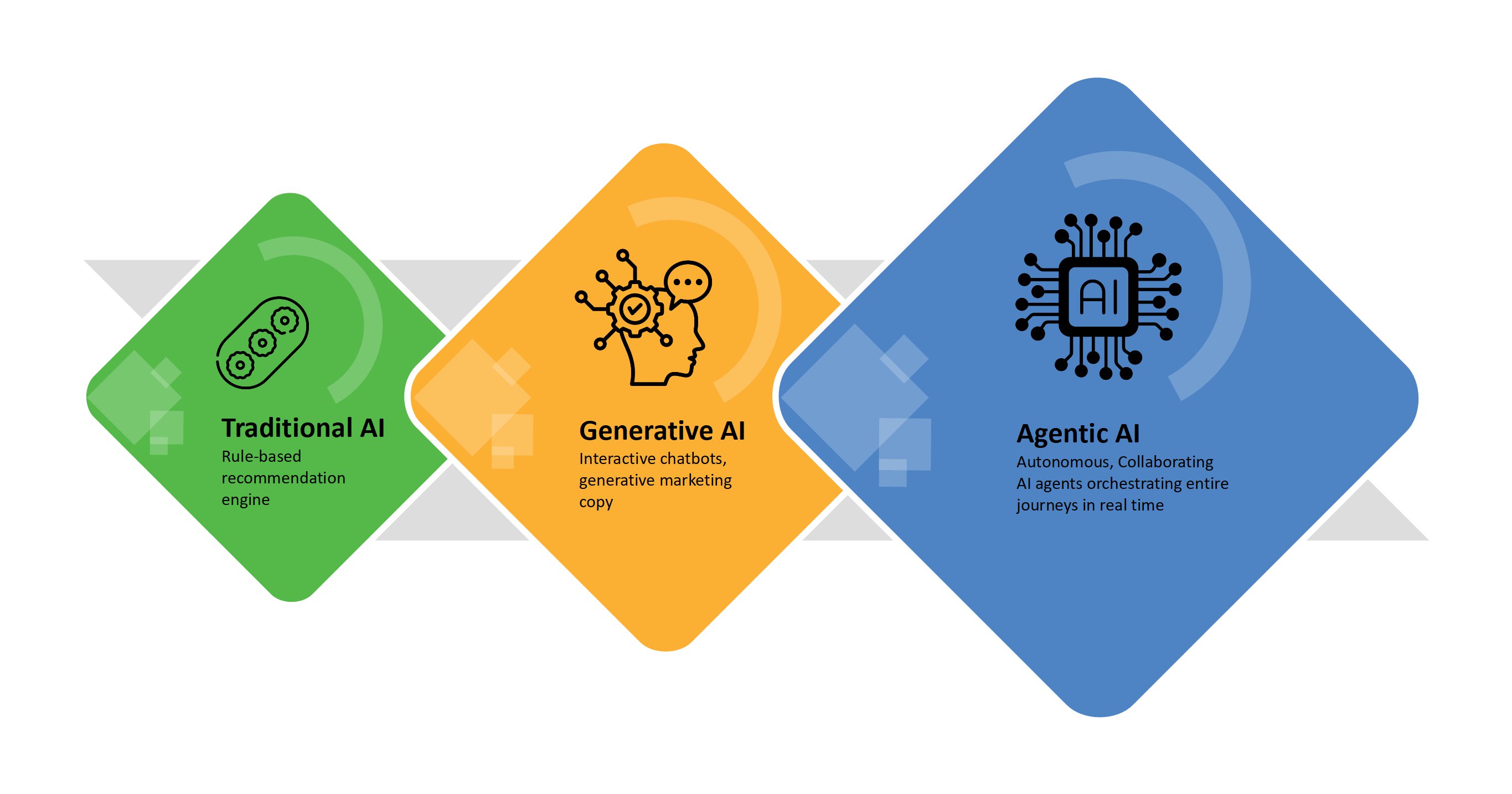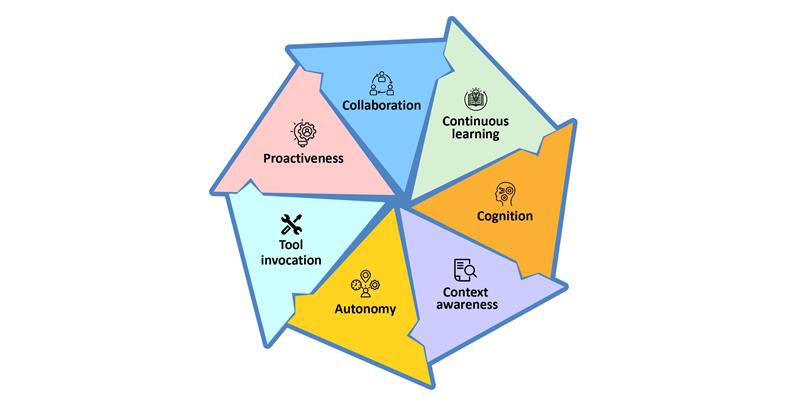Industry
HIGHLIGHTS
- Omnichannel fashion retailers looking to engage and retain customers in the long run need to invest in enhancing CX offerings as market competition intensifies, making it a strategic imperative to become more perceptive of customer needs.
- However, given the plethora of choices and ever-changing trends, offering the right personalized CX to customers becomes a challenge, especially in an omnichannel journey that traverses multiple channels.
- Agentic AI can make each of these journeys more cohesive, personalized, seamless, and meaningful while proactively being perceptive of customer needs.
On this page
CX strengthens brand loyalty
Customer experience (CX) plays a central role for retailers in building and sustaining relationships with end-consumers.
Investing in enhanced CX can help increase revenue and improve customer retention. This is especially true for omnichannel fashion retailers as they vie for customer attention in times of fierce competition. CX is, therefore, a strategic imperative for them to become more perceptive of customer needs and deliver exceptional experience to build lasting engagement, brand loyalty, and lifetime value (attract, engage, and retain). However, it has never been more difficult to capture and hold the attention of the digitally savvy customer in the backdrop of abundant choices and fleeting trends. This is now set to change thanks to agentic AI that can enable omnichannel fashion retailers to deliver exceptional experience to their customers.
Agentic artificial intelligence (AI) provides unprecedented capabilities for retailers to orchestrate hyper-personalized and seamless customer journeys, while proactively anticipating and responding to customer needs. Multiple AI agents can work in concert to autonomously execute tasks, automate data reconciliation and analytics, understand people and contexts, learn from interactions, and provide curated, real-time information and proactive assistance, effectively reducing friction, improving engagement, and delivering favorable experience, ultimately leading every customer journey to a successful, satisfactory closure.
The global fashion retail market is awakening to the value of agentic AI given its ability to automate tasks, personalize experiences, and optimize operations. Going forward, omnichannel fashion retailers at large stand to gain from adopting agentic AI.
Agentic AI is poised to revolutionize omnichannel fashion CX by enabling retailers to become more perceptive of customer needs, with meaningful insights derived from data.
Agentic AI redefines fashion retail
Agentic AI is poised to revolutionize the way brands engage with customers.
Agentic AI has evolved from Generative AI (GenAI) (see Figure 1) and amplifies the capability of GenAI by adding autonomy, multi-agent collaboration, contextual awareness and orchestration through tool invocation.
Agentic AI is based on networks of autonomous, intelligent ‘AI agents’. These agents aren’t passive tools but active orchestrators of customer journeys. They can adapt to dynamic retail environments, learn from interactions with customers, integrate enterprise data, and interact with humans to deliver deeply resonant experiences with minimal to no human intervention. As a result, fashion retailers can achieve new levels of personalization, greater operational efficiency, and more impactful customer engagement.
The hallmarks of agentic AI, supported by its core principles (see Figure 2) include:
- Cognitive capability: Sophisticated reasoning and natural language understanding to accurately decipher customer intent
- Autonomous action and tool invocation: Can invoke an arsenal of tools–APIs, web resources, enterprise systems–to access real-time data and act on it
- Collaboration: AI agents form intelligent networks that orchestrate complex tasks, share insights, and deliver cohesive, seamless customer journeys
- Proactive engagement: AI agents anticipate customer needs, proactively offer assistance, and continuously optimize the experience
Reimagined CX
Retail customer journeys span multiple stages–awareness, consideration, decision, purchase, and post-purchase.
Moreover, the journeys can be routed through different channels, interact with data in different systems, and follow different time patterns.
Agentic AI can make each of these journeys more cohesive, personalized, and meaningful.
Meet Sarah, a customer looking for a party dress. She’s open to recommendations. While a generative AI-enhanced journey can serve relevant recommendations and offer reactive content, agentic AI can transform Sarah’s shopping experience through autonomous, collaborative agents. Here’s a glimpse of the key phases in her shopping journey:
Sample customer journey orchestrated with AI agents
| Phase in Sarah’s journey | Gen-AI version | Agentic AI version |
| Discovery | Relevant recommendations based on past data. However, Sarah will need to search and filter. | A ‘personal shopping agent’ collaborates with a ‘trend analysis agent’ (monitoring real-time fashion trends) and an ‘inventory awareness agent’ (tracking stock). They autonomously curate a dress collection tailored to Sarah’s needs before she starts her search. |
| Exploration | Rich product descriptions and static styling tips, but limited interaction. | A ‘virtual stylist agent’ invokes an AR try-on tool, collaborates with a ‘knowledge retrieval agent’ for styling expertise, and proactively offers personalized advice, adapting to Sarah’s preferences in real time. |
| Purchase and post purchase | Reactive chatbots handle basic queries but falter with complex issues, requiring human intervention. | A ‘journey orchestration agent’ oversees the process, partnering with a ‘logistics agent’ for delivery updates, a ‘customer support agent’ for proactive issue resolution, and a ‘promotion agent’ to offer a tailored accessory discount post purchase. |
Amplifying outcomes
Traditional AI excels at identifying patterns from historical data and in tackling core challenges like demand forecasting.
Agentic AI, however, marks a technological inflection point repositioning AI from being a tool that can generate insights to a business stakeholder. It can learn from the insights, make decisions, and execute operational tasks as an autonomous actor to deliver unprecedented outcomes.
| Use case | Traditional AI (insight and prediction) | Agentic AI (execution and automation) | Amplified ‘agentic-AI outcome’ | Business benefit, CX uplift |
| Personalized styling, lookbooks, and campaigns | Customer segment level product affinity prediction | ‘Stylist agent’ draws style insights from multi-source data, collaborates with ’customer profile agent’ to generate personalized lookbook visuals, craft compelling campaign messaging in line with the brand voice, and execute targeted campaign delivery. | Contextualized personalization delivered automatically at scale. | Improved engagement, higher conversion rates, deeper brand loyalty. |
| Real-Time inventory and supply chain coordination | Demand forecasting, inventory optimization, optimal stock level insights. | ‘Inventory agent’ monitors real-time stock levels, automatically initiates reorders, coordinates with ‘Vendor agents’ or ‘fulfilment agents’ to check availability, re-route shipments, or find alternative sources. | Optimized inventory levels through rapid execution of replenishment and logistics adjustments. | Better availability, low probability of stockouts. |
| Dynamic pricing and promotion management | Price optimization, promotional strategies. | ‘Pricing agent’ monitors real-time market conditions. It draws insights, takes decisions and executes pricing adjustments or activates promotions in real time to maximize preset business goals. | Data-driven pricing strategies executed instantly and accurately across channels. | Reacting swiftly to market dynamics so the customers always get the best price and deal. |
| Customer service and support | Insights from sentiment analysis, topic modelling. | ‘Customer service agent’ receives and interprets natural language queries. It calls other agents like ‘policy agent’, and ‘order agent’ for information retrieval, handles standard transactional requests (eg, return initiation) autonomously, and seamlessly escalates complex issues with full context to human agents. | Faster response times, consistent and accurate information delivery, reduced operational costs. | Responsive, rapid support, driving satisfaction and deepening brand trust. |
| In-store experience and workforce optimization | Store footfall traffic prediction, workforce planning insights. | ‘In-store agent’ monitors real-time conditions (eg, queue length) and coordinates with a ‘workforce agent’ to dynamically adjust staff assignments. | Efficient staff allocation with real-time, automated adjustments. | Enhanced in-store experience, optimized labor cost. |
| Reverse logistics and sustainability | Return-reason analysis, optimal disposition path prediction. | ‘Returns agent’ automates the returns workflow triggered by the customer. It invokes the ‘payments agent’ to issue a refund and a ‘Sustainability agent’ to track and trace recycling and disposal. | Streamlined, cost-effective returns management informed by data-driven disposition strategies, supporting sustainability goals. | Better post-purchase experience, enhanced brand reputation. |
Adopting agentic AI
Adopting agentic AI in fashion retail requires a strategic approach while ensuring a handle on its unique challenges.
The following road map provides a practical approach to seamlessly and successfully integrate agentic AI into a fashion retail ecosystem.
Agentic AI adoption in phases
| Phase 1 | Quick wins to unlock and demonstrate value |
|
| Phase 2 | Strategic transformation for broader impact |
|
| Phase 3 | Big bets for market differentiation |
|
| Phase 4 | Continuous improvement for leadership |
|
Like any complex technology, adopting agentic AI comes with its inherent challenges, more so because of its autonomous and cognitive capabilities that need suitable handling and guardrails. However, businesses can navigate these challenges with the agentic AI best practices.
Access to a variety of customer and enterprise data raises questions about data governance, risk of breaches, and compliance obligations. Adopt robust anonymization and encryption techniques while adhering to relevant regulations, maintain a high degree of transparency with stakeholders to overcome this challenge.
Bias in training data can lead to skewed recommendations or promotions. This can be tackled by implementing bias detection, ensuring diverse data inclusion, and keeping human oversight for sensitive decisions.
Implementing always-on, agent-driven orchestration demands stable and scalable platforms. This can be achieved with microservices-based architectures, containerization, or serverless deployments that let agents seamlessly call internal and external application programming interfaces (APIs).
Measuring and attributing success is not always straightforward. Defining clear, relevant key performance indicators (KPIs) to validate AI investments—ranging from increased average order value to reduced returns or heightened brand advocacy—will help ascertain the returns.
The way forward
CX will continue to be a key driver of growth for an omnichannel fashion retailer.
Retailers are looking for ways to get a deeper understanding of their customers to become more perceptive of their needs. This knowledge is being deployed to effectively compete primarily on CX as product differentiation diminishes, and customers tend to value their experience with a brand as much as its products or services.
GenAI has the potential to be a game-changer for fashion retail, offering capabilities such as content generation, product recommendations, and responsive chatbots. However, delivering the next level of customer experience will require enterprises to become more perceptive and meet the customer as a single, intelligent entity, with deep understanding and empathy to proactively anticipate needs and challenges. This, in turn, will help them offer memorable, hyper-personalized experiences at every touchpoint. Agentic AI can enable this by weaving continuous learning, autonomy, and multi-agent collaboration into every stage of the retail value chain.
Collaborating with the right technology partner can help retailers become more perceptive of customer needs, acquire the know-how to accelerate agentic AI adoption, and navigate such challenges and roadblocks as:
- Identifying the right opportunities; using agentic AI to solve the biggest pain points to demonstrate value
- Choosing the appropriate types of agentic AI models suited to the context
- Integrating the widest range of data sources to the agents
- Training and testing the agents for accuracy, transparency, and consistency
Agentic AI improves CX significantly and heralds a future where retail is perceptive, autonomous, intelligent, and customer-centric. Early and responsible adoption of agentic AI, therefore, is vital for the growth of fashion retailers.


